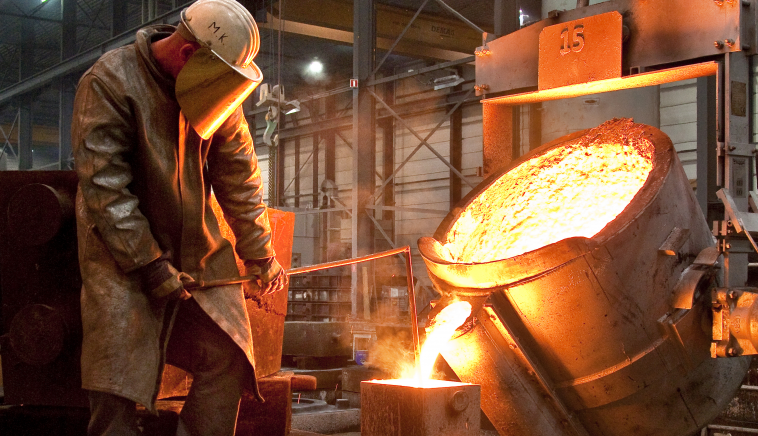Foundry/Gilsonite usage in foundry

Gilsonite in Foundry
The technology of melting metals and alloys and the shape and condition of them is called Foundry.
for high value iron castings, Gilsonite performs like no other. Its naturally superior properties mean high-quality castings with better finish and fewer imperfections.Foundries around the world have known for decades that when put to the fire of molten iron Gilsonite brings high performance to your foundry sand. For your complex, high value iron castings, Natural Bitumen performs like no other carbon additive. Gilsonite s naturally superior properties mean high-quality castings with better finish and fewer imperfections.Three times as much gas generated as sea coal for better mold release High lustrous carbon for better finish Reductive atmosphere for less reaction between mold and casting for fewer imperfections.
Gilsonite is combined with coal and other ingredients as an additive in foundry sands to insure the quality of the molded part. The lower gas evolution should reduce ventilation load on the pouring floor. The physical property relationships developed in new sand mixes were confirmed by sand using Gilsonite as an additive. Casting finish of a Gilsonite mix has been equal to sea coal. Gilsonite is also used as a carbonated additive in casting sands that creates smoother plates on gray iron castings. In a lower temperature than coal, it makes the material volatile so that it improves the process of separating the metal from the mold.Moreover, the surface of the mold is smoother and cleaner.
Gilsonite can be used as an additive to or a replacement to sea coal or other common carbonated additives in foundry. One of the great advantages of using Gilsonite on sand mold is increasing the hot resistance, increasing the pure (dry) resistance, decreasing the penetration and increasing the hardness of the mold. . Physical Sand properties with Gilsonite resin are equal or superior to sea coal at significantly lower additive levels.
Foundry Sand
This sand is of a special type and mainly silica sand, which is obtained in limited areas in Iran and is used depending on the type and appearance of sand grains in the casting of small and large steel parts. Of course, there are other uses of this sand, especially in the treatment of drinking water and … But more than 80% of the mining of this mineral sand is used in the casting industry.
Clay with water is used as a sandblast. General composition: 90% sand, 7% clay and 3% water.Other adhesives that are used include:
- Organic dressings (such as phenolic resins )
- Inorganic labels (sodium silicate and phosphate)
- Other alternatives, sometimes to increase strength and degradability
- Sand adds to it.
Gilsonite as a Carbonaceous Foundry Sand Additive
One of the most important additives for foundry sand is Gilsonite. Adding Gilsonite to sand foundry will make adhesion between sand and other materials.
This adhesion after filling the mold causes the gassing out of the Gilsonite sublimation to squeeze the material so that it is easier to separate the mold from the casting material. Meanwhile, the mold surfaces remain highly polished.
Gilsonite improves sand density, water requirements and strength (green, dry, baked, and hot). Gas evolution curves show that Gilsonite volatilizes more rapidly than sea coal. Gilsonite has the same total volatiles as sea coal at one-third the additive level.During pouring, the gases given off from the carbonaceous additives form a gaseous film which prevents the molten metal from making direct contact with the clay-coated sand grains,reducing sand-metal contact and consequently burn-on. When heated,the carbonaceous materials provide volatile, hydrocarbon gases which then pyrolyse to deposit a lustrous carbon graphitic layer in the metal-mold interface region. This deposition acts as a physical barrier to iron silicate formation as well as not being readily wetted by molten iron. The combination effect is to inhibit burn-on and penetration.
A. Burn-on: Sand grains firmly bonded to casting.
B. Burn-off: Casting surface has rough, sandy appearance.
C. Metal penetration: Metal penetrates into voids between sand grains forming fused mass of metal and sand, casting difficult to remove.
D.Pin holes, caused by high nitrogen content.
Benefits of Gilsonite foundry sand
- Reduces imperfections due to the rapid reaction between the silica sand mold and the oxidized surface of molten iron.
- Improves sand peel from casting at shakeout.
- Produce smoother, cleaner casting surface.
- Minimise imperfections, casting losses, scrap.
In Foundry and Refractories, for molding high value metals there is more attention to factors such as finishing. Gilsonite can be a superior carbon additive replacing the traditional Sea Coal which has low Carbonic value compared to Gilsonite Specifications.
Gilsonite has
• Three times as much gas generated as sea coal for better mold release
• High lustrous carbon for better finish
• Reductive atmosphere for less reaction between mold & casting for fewer
imperfections .
Ratio of Gilsonite in Foundry
Although the ratio of one part iron oxide, one part of a highly volatile carbonaceous material such as gilsonite and four parts of metallurgical coke in the additive is a preferred ratio to reduce smoke and/or emissions and give proper finish to the castings, some variations may be permissible. When the additive is combined with the clay, the nominal percentages by weight of the blend would be around 4% iron oxide, 4% gilsonite and 16% metallurgical coke, the balance being essentially 70% to 75% clays and small amounts of other materials.In the case of greater than normal amounts of smoke and/or emissions, the amount of the iron oxide can be increased in steps of 0.5% of the blend with a similar reduction in the metallurgical coke. In the case of poor shakeout peel or casting surface problems, the highly volatile carbonaceous material such as uintaite can be increased in 0.5% steps with a similar reduction in the clay portion of the blend. The permissible ranges of constituents beyond which the additive would be less effective, expressed as a percentage by weight of the blend, are 2%-6% iron oxide, 6%-2% uintaite, and 12%-18% metallurgical coke.
Packing of Foundry Gilsonite Natural Asphalt Lump and Powder Form
- Gilsonite in lump form like rock packed in the 500~1000 kg jumbo bag
- Gilsonite 200 mesh packed in the 500~1000 kg jumbo bag
- Gilsonite 300 mesh packed in the 500~1000 kg jumbo bag
- Gilsonite 30-40 mesh packed in the 500~1000 kg jumbo bag
- Gilsonite 100 mesh packed in the 500~1000 kg jumbo bag
- Gilsonite 300 mesh packed in 25 kg pp bag
- Gilsonite 200 mesh packed the 25 kg multi-paper bag
- Gilsonite 200 mesh packed the 50 lbs multi-paper bag
- Gilsonite 30-40 mesh packed pp bag on the pallet
- Bulk on vessel
Analysis of Gilsonite Foundry
| NO | TEST | RESULT | TEST METHOD |
| 1 | ASH CONTENT,WT% | 10 | ASTM-D3174 |
| 2 | MOISTURE CONTENT,WT% | 0.5% | ASTM-D3173 |
| 3 | VOLATILE MATTER,WT% | 64 | ASTM-D3175 |
| 4 | SOLUBILITY IS CS2,WT% | 78 | ASTM-D4 |
| 5 | SPECIFIC GRAVITY @25C | 1.11 | ASTM-D3289 |
| 6 | NORMAL NEPTHAN INSOLUBLES,WT% | 79 | ASTM-D3279 |
| 7 | COLOR IS MASS | BLACK | ———————– |
| 8 | COLOR IN STREAK OR POWDER | BLACK | ———————– |
| 9 | SOFTENING POINT,C | 150 | ASTM-D36 |
| 10 | PENETRATION @25C | 0 | ASTM-D5 |
ELEMENT ANALYSIS
| 1 | CARBON,WT% | 78 | ASTM-D5291 |
| 2 | HYDROGEN,WT% | 7.1 | ASTM-D5291 |
| 3 | NITROGEN,WT% | 3.67 | ASTM-D5291 |
| 4 | OXYGEN,WT% | 3.1 | ASTM-D5291 |
| 5 | SULPHURE,WT% | 2 | LECO(S)ANALYSER |

